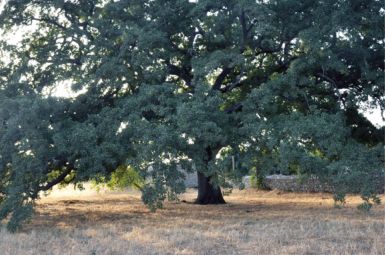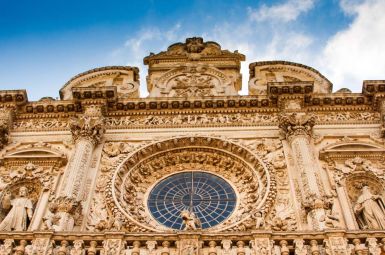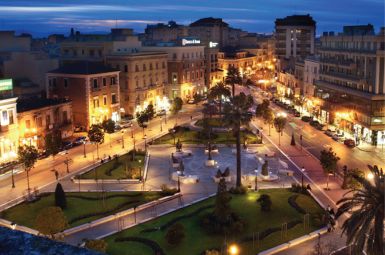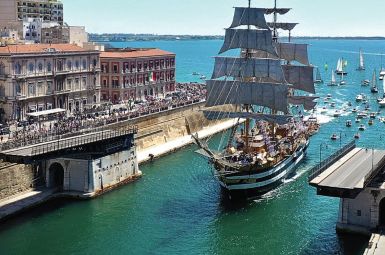
Pietradefusi
Il Borgo di Pietradefusi
Pietradefusi: Dove la Pietra, la Storia e il Taurasi si Fondono
Pietradefusi, incastonato tra le fertili colline dell’Irpinia, è un borgo che racchiude in sé l’essenza della Campania interna. Il suo nome, letteralmente “pietra fusa”, evoca l’antica “Università di Pietra de’ Fusi”, un luogo dove genti e tradizioni diverse si sono unite nel tempo per creare un patrimonio unico, oggi simbolo di resilienza e di eccellenza enogastronomica.La Storia Fortificata: Il Cuore Medievale del Borgo
Il nucleo centrale del paese è dominato da una maestosa presenza che ne definisce l’identità: la Torre Aragonese.- Sentinella di Pietra: Edificata nel 1431 per volere del nobile Giacomo de Tocco, la Torre serviva originariamente per controllare il versante sinistro del fiume Calore e per la riscossione delle rendite feudali. Nonostante il nome, fu possesso anche degli Acquaviva d’Aragona. Oggi, la sua sagoma quadrangolare, sottoposta a restauri, è il fulcro attorno al quale si sviluppa il centro storico, custode di resti romani incastonati nelle mura delle antiche abitazioni.
- Architetture di Fede: Adiacente alla Torre sorge la monumentale Chiesa Maria SS. Annunziata, costruita nel 1728 per volere del Cardinale Nicolò Coscia, nativo del borgo. La sua imponenza e i suoi rifacimenti, resi necessari dai frequenti eventi sismici, raccontano la tenacia della comunità nel preservare la propria identità spirituale e artistica.
Eccellenza Enologica e Dolce Tradizione
Pietradefusi non è solo storia, ma anche terra fertile baciata da una vocazione agricola millenaria, specialmente nel settore vitivinicolo.- Patria del Taurasi DOCG: Le colline circostanti sono parte integrante del distretto di produzione del Taurasi DOCG, uno dei vini rossi più pregiati del Sud Italia, a base di uve Aglianico. Il paesaggio è un mosaico di vigneti che produce vini rossi strutturati e longevi, ambasciatori dell’Irpinia nel mondo.
- Dentecane, La Capitale del Torrone: Nella frazione di Dentecane, l’artigianato dolciario raggiunge vette di eccellenza. Questa località è universalmente nota per la produzione artigianale del Torrone (o Copeta), un dolce tradizionale che, grazie alla sua alta qualità, viene esportato in tutto il mondo, rendendo Pietradefusi un nome di riferimento per la dolcezza.
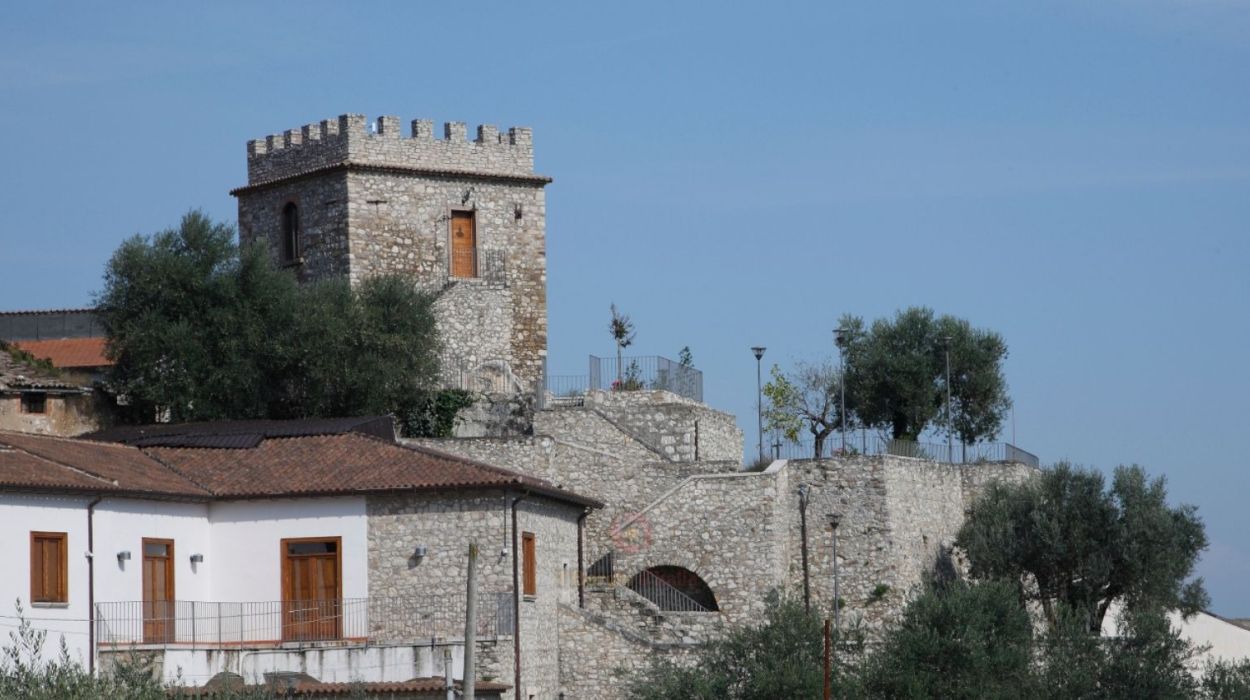
Il Borgo d’Italia
tutto da scoprire ed esplorare
Monumenti
Pietradefusi: La Memoria in Pietra, Tra Antiche Torri e Fede Barocca
Pietradefusi, piccolo gioiello irpino incastonato tra le fertili valli campane, è un luogo dove la storia non è solo raccontata, ma si erge solida, forgiata nella pietra viva. Il suo centro storico, sviluppatosi attorno a un’antica sentinella medievale, custodisce tesori che parlano di nobili lignaggi, devozione profonda e architetture che sfidano i secoli.
La Torre Aragonese: Il Cuore Fortificato del Borgo
Nessuna visita a Pietradefusi può dirsi completa senza aver ammirato la Torre Aragonese . Edificata nel 1431 per volere di Giacomo de Tocco, questa imponente struttura quadrangolare è il punto focale attorno al quale l’intero centro abitato ha preso forma.
- Sentinella di Storia: Nata con funzioni di controllo feudale sul versante sinistro del fiume Calore e di riscossione delle rendite, la Torre si erge fiera, con i suoi circa 11 metri di altezza, direttamente sulla roccia viva.
- L’Eredità Feudale: Sebbene costruita prima del dominio aragonese, deve il suo nome ai duchi Acquaviva d’Aragona, che ne furono feudatari tra il XV e il XVII secolo.
- Oggi: Restaurata e valorizzata, la Torre non è più un baluardo difensivo, ma un centro culturale pulsante, spesso sede di mostre ed eventi che ne valorizzano la maestosa eredità.
La Collegiata Maria SS. Annunziata: L’Eleganza del Settecento
A breve distanza dalla Torre, sulla piazza principale del paese, sorge la Chiesa di Maria Santissima Annunziata, conosciuta anche come l’Antica Collegiata. Un’opera che testimonia il legame indissolubile tra la comunità e i suoi illustri concittadini.
- Un Atto d’Amore: Edificata nel 1728 per iniziativa del Cardinale Nicolò Coscia, nativo di Pietradefusi, la chiesa è un sublime esempio di architettura religiosa che domina la scena urbana.
- Magnificenza Barocca: Nonostante i danni subiti (come quelli causati dalle truppe francesi nel 1799) e le successive ricostruzioni, la Collegiata mantiene la sua monumentalità, con una facciata imponente e un interno ampio, caratterizzato da un’unica navata con cappelle laterali.
- I Simboli della Devozione: Al suo interno, e in particolare nell’adiacente Santuario dedicato a Maria SS.ma dell’Arco, è custodita un’imponente statua lignea della Vergine del 1713. Inoltre, la Collegiata conserva con devozione le sacre spoglie di San Faustino Martire, Patrono del Comune, traslate qui nel 1717 per volere del Cardinale Coscia.
Questi monumenti non sono semplici strutture, ma i capitoli più eloquenti della storia di Pietradefusi: dalla vigilanza medievale della Torre alla fede operosa espressa nella Collegiata. Un viaggio nel borgo è un’esperienza immersiva nella Pietra di Fusis, dove il passato e il presente si fondono in un patrimonio culturale di inestimabile valore.
Curiosità
Pietradefusi: Quando la Storia Profuma di Torrone e Antichi Misteri
Pietradefusi non è solo un borgo irpino di notevole bellezza, dominato dall’austera Torre Aragonese. È un crocevia di storie inattese, di tradizioni culinarie secolari e di personaggi che hanno lasciato un segno profondo, anche con risvolti controversi, nella storia italiana ed ecclesiastica.
La Capitale del Gusto: Dentecane e il Torrone
La curiosità più “dolce” e di risonanza nazionale è legata alla frazione di Dentecane. Questa località è universalmente riconosciuta come la Patria del Torrone .
- Dolce Secolare: La produzione di questo squisito dolce a base di miele, albumi e frutta secca ha radici antichissime, con torronifici storici attivi sin dal 1750.
- Artigianalità Riconosciuta: Ancora oggi, la lavorazione dell’impasto avviene sui tradizionali tavoli di granito, con le stecche che vengono tagliate a mano, una per una. Una dedizione che ha portato il Comune a far parte dell’Associazione Italiana Città del Torrone.
- L’Antica Via Appia: Il successo di Dentecane non è casuale: la frazione si trovava su un nodo cruciale della Regina Viarum, l’antica Via Appia, favorendo l’abbondanza di materie prime e la diffusione del dolce in tutto il mondo mediterraneo.
Il Cardinale Scomodo: La Figura di Niccolò Coscia
Pietradefusi diede i natali a una delle figure più controverse del Settecento italiano: il Cardinale Niccolò Coscia (1682-1755). La sua storia è un dramma di ascesa e caduta che si lega al borgo:
- Protettore e Benefattore: Nato da una famiglia di umili origini, Coscia raggiunse la carica di Arcivescovo di Benevento e fu elevato a Cardinale da Papa Benedetto XIII. Per “amore della terra nativa” fece erigere la monumentale Chiesa di Maria Santissima Annunziata nel 1728.
- La Trama Politica: Durante il pontificato di Benedetto XIII, Coscia esercitò un potere notevole, ma fu aspramente criticato e accusato di aver gestito le finanze papali in modo disonesto.
- Caduta in Disgrazia: Dopo la morte del Papa, il Cardinale fuggì da Roma. Fu processato, scomunicato e condannato nel 1733 per appropriazione indebita e falsificazione, scontando dieci anni di prigione. Un destino che rende il suo lascito a Pietradefusi, come la splendida Collegiata, un monumento avvolto da una storia affascinante e tumultuosa.
Echi Medievali e Sapori Tradizionali
- L’Origine del Nome: Il toponimo Pietradefusi deriva probabilmente da “Pietra de’ Fusi”, indicando sia la roccia calcarea su cui furono costruite le prime abitazioni (la “pietra”), sia l’unione di genti diverse che qui si stabilirono, come fossero “fuse” insieme (i “fusi”).
- Il Piatto della Domenica: La tradizione culinaria non si ferma al torrone. Il piatto tipico della domenica è la Braciola Pietradefusana, una ricetta ingegnosa che consiste in fette di carne bovina arrotolata con formaggio ed erbe. Questa viene cotta a fuoco lento per ore all’interno del ragù, permettendo di preparare con un unico fuoco il secondo e il sugo per i celebri Fusilli fatti a mano (un tempo arrotolati attorno a un ferro chiamato “fusillo”).
- Resti Romani: Nonostante la sua forte impronta medievale e barocca, nel centro storico, sviluppatosi attorno alla Torre, si possono ancora osservare resti romani incastonati nelle mura di alcune case, a testimonianza della lunghissima storia del territorio lungo l’antica via consolare.
Personaggi
Pietradefusi: La Terra che Genera Figure di Calibro Storico e Sportivo
Pietradefusi non è soltanto il borgo del torrone e della storica Torre Aragonese, è anche la culla di personalità che hanno inciso profondamente nella storia ecclesiastica, nella dirigenza sportiva italiana e persino, secondo alcune fonti, nelle pagine della letteratura internazionale. La sua terra ha dato i natali a figure complesse e di alto profilo.
Niccolò Coscia: Il Cardinale Controverso
Il personaggio storico più noto e discusso originario di Pietradefusi è senza dubbio il Cardinale Niccolò Paolo Andrea Coscia (1682-1755). La sua vita è un racconto di ascesa fulminea e caduta clamorosa:
- Potere Vaticano: Partito da umili origini, Coscia divenne il favorito di Papa Benedetto XIII (già Cardinale Orsini), arrivando a ricoprire le cariche di Arcivescovo di Benevento e Cardinale Segretario di Stato de facto. Esercitò un’influenza enorme sul governo dello Stato Pontificio.
- Benefattore e Costruttore: L’amore per la sua terra natia lo spinse a finanziare la costruzione della magnifica Chiesa di Maria Santissima Annunziata nel centro del paese.
- Il Triste Epilogo: Dopo la morte del Papa, il Cardinale fu travolto da accuse di malgoverno e appropriazione indebita. Fu condannato, scomunicato e imprigionato, finendo per ritirarsi a Napoli dopo il condono della pena. La sua figura resta legata a uno dei periodi più turbolenti della storia ecclesiastica del Settecento.
Federico Sordillo: Il Presidente del Mondo
Dalle sacre stanze al campo da gioco, Pietradefusi vanta anche legami con la storia sportiva italiana attraverso l’avvocato e dirigente Federico Sordillo (1927-2004).
- Dirigenza di Alto Livello: Nato nella frazione di Dentecane, Sordillo fu una figura chiave nel mondo del calcio. Fu Presidente del Milan (negli anni ’71-’72) e, soprattutto, Presidente della Federazione Italiana Giuoco Calcio (FIGC) dal 1980 al 1986.
- L’Eroe del Mundial ’82: Sordillo legò indissolubilmente il suo nome al terzo titolo mondiale conquistato dalla Nazionale Italiana ai Campionati del Mondo del 1982 in Spagna, rappresentando l’Italia nell’epico momento di rinascita del calcio nazionale.
Altri Figli Illustri (e un Mistero Letterario)
La tradizione locale e le fonti storiche ricordano altre personalità che hanno arricchito il prestigio del borgo:
- Claudio d’Aragona (o Acquaviva): Alcune testimonianze legano a Pietradefusi (o più precisamente alla famiglia che deteneva il feudo) la figura di Claudio d’Aragona, Quinto Preposito Generale dell’Ordine dei Gesuiti nel XVI secolo, noto per aver promosso la celebre Ratio Studiorum, il sistema formativo gesuita.
- Il Presunto Legame con Puzo: Infine, una curiosità che attraversa l’oceano. Alcune fonti sostengono che il padre di Mario Puzo, il celebre autore de Il Padrino, fosse originario di Pietradefusi, proiettando un inatteso fascino letterario sull’identità del paese.
Questi illustri concittadini, siano essi cardinali controversi, presidenti che hanno fatto la storia del calcio o figure della Controriforma, dimostrano come Pietradefusi sia stata, nel corso dei secoli, una fucina di talenti capaci di lasciare un’impronta indelebile ben oltre i confini dell’Irpinia.
Ricette Tipiche
Un Viaggio Sensoriale nel Cuore dell’Irpinia: Le Delizie di Pietradefusi
Pietradefusi, custode di tradizioni secolari e sapori autentici, offre un panorama gastronomico che celebra l’opulenza della terra irpina. I suoi piatti, semplici nelle radici ma ricchi nel gusto, sono il perfetto emblema della cucina campana di terra. Ecco un tributo alle sue creazioni culinarie più emblematiche.
I Primi Iconici: Fusilli al Ragù
I Fusilli al ferretto rappresentano la quintessenza della pasta fresca campana e irpina. A Pietradefusi e nei paesi limitrofi, questa pasta dalla forma spiralata, lavorata artigianalmente avvolgendo l’impasto attorno a un sottile ferretto, è il piatto della festa, l’abbraccio domenicale della tradizione.
- Il Formato: Ottenuti da un impasto base di semola di grano duro, talvolta arricchito con farina “00” e acqua, i fusilli hanno la capacità unica di catturare ogni goccia di condimento.
- Il Condimento: Vengono tradizionalmente esaltati dal Ragù di Carne, un sugo lento e opulento a base di carni miste (spesso maiale, agnello e vitello) cotte per ore. Il risultato è un primo piatto di sapore intenso, dove la pasta diventa un veicolo perfetto per la ricchezza del sugo.
- Tocco Finale: Una generosa spolverata di Pecorino grattugiato è d’obbligo.
Il Secondo della Tradizione: La Braciola al Sugo
Come in gran parte della Campania, la Braciola al Ragù è un caposaldo del patrimonio gastronomico, un secondo piatto che nasce nel sugo per conferirgli profondità e sapore.
- La Preparazione: Si tratta di involtini di carne di manzo, spesso tagli di spalla o copertina, accuratamente battuti per assottigliarli.
- Il Ripieno: Il cuore della Braciola irpina è un ripieno saporito e aromatico, che tipicamente include:
- Aglio e Prezzemolo tritati finemente.
- Pecorino o formaggio locale grattugiato.
- Uvetta e Pinoli, un tocco agrodolce che bilancia il sapore intenso della carne e del sugo.
- La Cottura: Le braciole, una volta arrotolate e sigillate con spago o stecchini, vengono rosolate in olio, sfumate con vino rosso (spesso Aglianico) e poi immerse nella passata di pomodoro per una cottura lenta e prolungata (anche due ore), trasformandosi in un secondo piatto tenerissimo la cui carne si scioglie in bocca.
Il Dolce Capolavoro: Il Torrone di Dentecane
L’eccellenza dolciaria di Pietradefusi è legata indissolubilmente alla sua frazione, Dentecane, riconosciuta come una delle capitali italiane nella produzione di Torrone.
- La Maestria Artigianale: La lavorazione di questo dolce è un’arte tramandata per generazioni. L’impasto di albume d’uovo, zucchero e miele viene cotto lentamente a temperatura costante per una notte intera, conferendo al torrone la sua consistenza unica.
- Gli Ingredienti: La base di candido impasto accoglie poi la frutta secca di alta qualità (mandorle, nocciole, noci).
- Le Varianti: Il Torrone di Dentecane si presenta sia nella versione bianca classica che, per i palati più esigenti, ricoperto di cioccolato fondente o al latte. Il processo, dalla modellatura manuale negli stampi tradizionali al taglio finale, garantisce un prodotto sopraffino apprezzato a livello nazionale e oltre.
